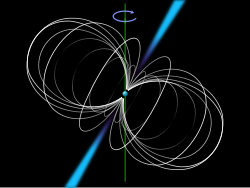PSR J0740+6620
 Schematic of a pulsar | |
| Observation data Epoch J2000 Equinox J2000 | |
|---|---|
| Constellation | Camelopardalis |
| Right ascension | 07h 40m 45.799s[1] |
| Declination | +66° 20′ 33.60″[1] |
| Characteristics | |
| Evolutionary stage | Pulsar |
| Details | |
| Mass | 2.08 M☉ |
| Radius | 13-15.1 km R☉ |
| Other designations | |
3FGL J0740.8+6621, 4FGL J0741.0+6618 | |
| Database references | |
| SIMBAD | data |
PSR J0740+6620 is a neutron star in a binary system with a white dwarf, located 4,600 light years away in the Milky Way galaxy. It was discovered in 2019, by astronomers using the Green Bank Telescope in West Virginia, U.S., and confirmed as a rapidly rotating millisecond pulsar.
As of 2019, it is among the most massive neutron stars ever observed – with 2.08+0.07
−0.07 solar masses[2][3][4] placing it near the boundary of the theoretical maximum.[5] Its mass was calculated via the Shapiro delay of its white dwarf companion as it passed edge-on to Earth.
PSR J0740+6620 is estimated to measure 13 km (8.08 mi)[6][7][8] in radius which is above the typical neutron star radius of 10 kilometres (6.21 mi) but still within a consistent range as expected uncertainties allow for radius as big as 15.1 km (9.38 mi).
See also[]
References[]
- ^ a b "PSR J0740+6620". SIMBAD. Centre de données astronomiques de Strasbourg. Retrieved 2021-10-23.
- ^ Fonseca, E.; Cromartie, H. T.; Pennucci, T. T.; Ray, P. S.; Kirichenko, A. Yu; Ransom, S. M.; Demorest, P. B.; Stairs, I. H.; Arzoumanian, Z.; Guillemot, L.; Parthasarathy, A. (1 July 2021). "Refined Mass and Geometric Measurements of the High-mass PSR J0740+6620". The Astrophysical Journal Letters. 915 (1): L12. arXiv:2104.00880. doi:10.3847/2041-8213/ac03b8. ISSN 2041-8205.
- ^ Kohler, Susanna. "Reweighing a Heavy Neutron Star". Retrieved 2021-08-20.
- ^ Cromartie, H. T.; Fonseca, E.; Ransom, S. M.; et al. (2019). "Relativistic Shapiro delay measurements of an extremely massive millisecond pulsar". Nature Astronomy. 4: 72–76. arXiv:1904.06759. doi:10.1038/s41550-019-0880-2. S2CID 118647384.
- ^ Green Bank Observatory (September 16, 2019). "Most massive neutron star ever detected, almost too massive to exist". ScienceDaily. Retrieved September 26, 2019.
- ^ Riley T, et al. (14 May 2021). "A NICER View of the Massive Pulsar PSR J0740+6620 Informed by Radio Timing and XMM-Newton Spectroscopy". arXiv:2105.06980.
- ^ Kazmierczak J (19 April 2021). "NASA's NICER Probes the Squeezability of Neutron Stars". NASA.
- ^ O'Callaghan J (26 May 2021). "Squishy Neutron Star Setback Dampens Hopes of Exotic Matter". Quanta Magazine.
External links[]
Susanna Kohler (15 September 2021). "More Insight into Neutron Star Interiors". AASnova.
- Pulsars
- Neutron stars
- Millisecond pulsars
- White dwarfs
- Binary stars
- Astronomical objects discovered in 2019
- Multiple star stubs
- Variable star stubs


